Naja
Naja is a genus of venomous elapid snakes known as cobras ("true cobras"). Members of the genus Naja are the most widespread and the most widely recognized as "true" cobras. Various species occur in regions throughout Africa, Southwest Asia, South Asia, and Southeast Asia. Several other elapid species are also called "cobras", such as the king cobra (Ophiophagus hannah) and the rinkhals (Hemachatus haemachatus), but neither are true cobras. They are not true cobras in that they do not belong to the genus Naja, but instead each belong to monotypic genera Hemachatus (the rinkhals)[1] and Ophiophagus (the king cobra/hamadryad).[2][3]
| Naja | |
|---|---|
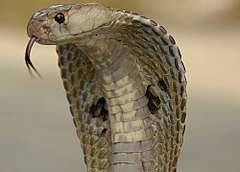 | |
| Indian cobra (Naja naja), the genera species typica | |
| Scientific classification | |
| Kingdom: | Animalia |
| Phylum: | Chordata |
| Class: | Reptilia |
| Order: | Squamata |
| Suborder: | Serpentes |
| Family: | Elapidae |
| Genus: | Naja Laurenti, 1768 |
| Type species | |
| Coluber naja Linnaeus, 1758 | |
Until recently, the genus Naja had 20 to 22 species, but it has undergone several taxonomic revisions in recent years, so sources vary greatly.[4] Wide support exists, though, for a 2009 revision[5] that synonymised the genera Boulengerina and Paranaja with Naja. According to that revision, the genus Naja now includes 38 species.[6]

Etymology
The origin of this genus name is from the Sanskrit nāga (with a hard "g") meaning "snake". Some hold that the Sanskrit word is cognate with English "snake", Germanic: *snēk-a-, Proto-IE: *(s)nēg-o-,[7] but this is unlikely. Mayrhofer calls this etymology "unglaubhaft ", "not credible", and suggests a more plausible etymology connecting it with Sanskrit nagna, "hairless, naked".[8]
Description
Naja species vary in length and most are relatively slender-bodied snakes. Most species are capable of attaining lengths of 1.84 m (6.0 ft). Maximum lengths for some of the larger species of cobras are around 3.1 m (10 ft), with the forest cobra arguably being the longest species.[9] All have a characteristic ability to raise the front quarters of their bodies off the ground and flatten their necks to appear larger to a potential predator.
Venom
| Rank | Species | LD50 SC |
|---|---|---|
| 1 | N. oxiana | 0.10 mg/kg[10] |
| 2 | N. philippinensis | 0.14 mg/kg[11][12] |
| 3 | N. samarensis | 0.21 mg/kg[13] |
| 4 | N. melanoleuca | 0.225 mg/kg[10][14] |
| 5 | N. siamensis | 0.25 mg/kg[10] |
| 6 | N. atra | 0.28 mg/kg[10][15] |
| 7 | N. naja | 0.29 mg/kg[10][15] |
| 8 | N. nivea | 0.37 mg/kg[15] |
| 9 | N. kaouthia | 0.47 mg/kg[10] |
| 10 | N. sumatrana | 0.60 mg/kg[16] |
All species in the genus Naja are capable of delivering a fatal bite to a human. Most species have strongly neurotoxic venom, which attacks the nervous system, causing paralysis, but many also have cytotoxic features which cause swelling and necrosis, and have a significant anticoagulant effect. Some also have cardiotoxic components to their venom.
Several Naja species, referred to as spitting cobras, have a specialized venom delivery mechanism, in which their front fangs, instead of releasing venom through the tips (similar to a hypodermic needle), have a rifled opening in the front surface which allows the snake to propel the venom out of the mouth. While typically referred to as "spitting", the action is more like squirting. The range and accuracy with which they can shoot their venom varies from species to species, but it is used primarily as a defense mechanism. Once sprayed onto a victim's skin, the venom acts as a severe irritant. If it is introduced to the eyes, it can cause a severe burning sensation and temporary or even permanent blindness if not cleaned out immediately and thoroughly.
The Caspian cobra (N. oxiana) of Central Asia is the most venomous Naja species. The average subcutaneous LD50 for N. oxiana in mice is 0.18 mg/kg, and the lowest reported value for N. oxiana is 0.10 mg/kg subcutis,[10] while the Philippine cobra (N. philippinensis) has an average murine LD50 of 0.2 mg/kg subcutis.[12] The lowest value reported for the Philippine cobra is 0.14 mg/kg subcutis.[11] In mice, the intravenous LD50 for the Caspian cobra is 0.037 mg/kg,[14] and for the Philippine cobra it is 0.05 mg/kg.[17] The Caspian cobra is the most venomous species of cobra in the world (to laboratory mice). The crude venom of N. oxiana produced the lowest known lethal dose (LCLo) of 0.005 mg/kg, the lowest among all cobra species ever recorded, derived from an individual case of poisoning by intracerebroventricular injection.[18] After the Caspian and Philippine cobras, the forest cobra (N. melanoleuca) has an LD50 of 0.225 mg/kg subcutis,[13][14] followed by the Samar cobra (N. samarensis), which has a value of 0.23 mg/kg subcutis.[13] The water cobras of Central Africa are also highly venomous. The murine intraperitoneal LD50 of Naja annulata and Naja christyi venoms were 0.143 mg/kg and 0.120 mg/kg, respectively.
The Naja species are a medically important group of snakes due to the number of bites and fatalities they cause across their geographical range. They range throughout Africa (including some parts of the Sahara where Naja haje can be found), Southwest Asia, Central Asia, South Asia, East Asia, and Southeast Asia. Roughly 30–40% of bites by some cobra species are dry bites, thus do not cause envenomation (a dry bite is a bite by a venomous snake which does not inject venom).
Many factors influence the differences in cases of fatality among different species within the same genus. Among cobras, the cases of fatal outcome of bites in both treated and untreated victims can be quite large. For example, mortality rates among untreated cases of envenomation by the cobras as a whole group ranges from 6.5–10% for N kaouthia[19] to about 70% for N. oxiana.[20] Mortality rate for Naja atra is between 15 and 20%,[19] 5–10% for N. nigricollis,[21] 50% for N. nivea,[19] 65–70% for N. melanoleuca, 20–25% for N. naja,[22] and 50–60% for N. samarensis.[23] In cases where victims of cobra bites are medically treated using normal treatment protocol for elapid type envenomation, differences in prognosis depend on the cobra species involved. The vast majority of envenomated patients treated make quick and complete recoveries, while other envenomated patients who receive similar treatment result in fatalities. The most important factors in the difference of mortality rates among victims envenomated by cobras is the severity of the bite and which cobra species caused the envenomation. The Caspian cobra (N. oxiana) and the Philippine cobra (N. philippinensis) are the two cobra species with the most toxic venom based on LD50 studies on mice. Both species cause prominent neurotoxicity and progression of life-threatening symptoms following envenomation. Death has been reported in as little as 30 minutes in cases of envenomation by both species. N. philippinensis's purely neurotoxic venom causes prominent neurotoxicity with minimal local tissue damage and pain[24] and patients respond very well to antivenom therapy if treatment is administered rapidly after envenomation. Envenomation caused by N. oxiana is much more complicated. In addition to prominent neurotoxicity, very potent cytotoxic and cardiotoxic components are in this species' venom. Local effects are marked and manifest in all cases of envenomation - severe pain, severe swelling, bruising, blistering, and tissue necrosis. Renal damage and cardiotoxicity are also clinical manifestations of envenomation caused by N. oxiana, though they are rare and secondary.[25] The untreated mortality rate among those envenomed by N. oxiana approaches 80%, the highest among all species within the genus Naja.[20] Antivenom is not as effective for envenomation by this species as it is for other Asian cobras within the same region, like the Indian cobra (N. naja) and due to the dangerous toxicity of this species' venom, massive amounts of antivenom are often required for patients. As a result, a monovalent antivenom serum is being developed by the Razi Vaccine and Serum Research Institute in Iran. Response to treatment with antivenom is generally poor among patients, so mechanical ventilation and endotracheal intubation is required. As a result, mortality among those treated for N. oxiana envenomation is still relatively high (up to 30%) compared to all other species of cobra (<1%).[26]
Taxonomy
| Naja |
| ||||||||||||||||||||||||||||||||||||||||||||||||||||||||||||||||||||||||||||||||||||||||||||||||||||||||||||||||||||||||||||||
The genus contains several species complexes of closely related and often similar-looking species, some of them only recently described or defined. Several recent taxonomic studies have revealed species not included in the current listing in ITIS:[4]
- Naja anchietae (Bocage, 1879), Anchieta's cobra, is regarded as a subspecies of N. haje by Mertens (1937) and of N. annulifera by Broadley (1995). It is regarded as a full species by Broadley and Wüster (2004).[27][28]
- Naja arabica Scortecci, 1932, the Arabian cobra, has long been considered a subspecies of N. haje, but was recently raised to the status of species.[29]
- Naja ashei Broadley and Wüster, 2007, Ashe's spitting cobra, is a newly described species found in Africa and also a highly aggressive snake; it can spit a large amount of venom.[30][31]
- Naja nigricincta Bogert, 1940, was long regarded as a subspecies of N. nigricollis, but was recently found to be a full species (with N. n. woodi as a subspecies).[32][33]
- Naja senegalensis Trape et al., 2009, is a new species encompassing what were previously considered to be the West African savanna populations of N. haje.[29]
- Naja peroescobari Ceríaco et al. 2017, is a new species encompassing what was previously considered the São Tomé population of N. melanoleuca.[34]
- Naja guineensis Broadley et al., 2018, is a new species encompassing what were previously considered to be the West African forest populations of N. melanoleuca.[6]
- Naja savannula Broadley et al., 2018, is a new species encompassing what were previously considered to be the West African savanna populations of N. melanoleuca.[6]
- Naja subfulva Laurent, 1955, previously regarded as a subspecies of N. melanoleuca, was recently recognized as a full species.[6]
Two recent molecular phylogenetic studies have also supported the incorporation of the species previously assigned to the genera Boulengerina and Paranaja into Naja, as both are closely related to the forest cobra (Naja melanoleuca).[32][35]
Wallach et al.[5] suggested recognition of four subgenera within Naja: Naja for the Asiatic cobras, Boulengerina for the African forest, water and burrowing cobras, Uraeus for the Egyptian and Cape cobra group and Afronaja for the African spitting cobras.
Species
| Image[4] | Species[4] | Authority[4] | Subsp.*[4] | Common name | Geographic range |
|---|---|---|---|---|---|
| N. anchietae | Bocage, 1879 | 0 | Anchieta's cobra (Angolan Cobra) | Angola, Botswana, Namibia, Zambia, eastern Zimbabwe | |
 |
N. annulata | (Buchholz and Peters, 1876) | 1 | Banded water cobra | Cameroon, the Central African Republic, the Democratic Republic of the Congo (Zaire), the Republic of Congo, Equatorial Guinea, Gabon, Rwanda, and the province of Cabinda in Angola |
 |
N. annulifera | Peters, 1854 | 0 | Snouted cobra | Botswana, Malawi, Mozambique, South Africa, Swaziland, Zambia, Zimbabwe |
| †N. antiqua | Rage, 1976 | 0 | Moroccan cobra | Miocene-aged strata of Morocco | |
| N. arabica | Scortecci, 1932 | 0 | Arabian cobra | Oman, Saudi Arabia, Yemen | |
| N. ashei | Wüster and Broadley, 2007 | 0 | Ashe's spitting cobra (giant spitting cobra) | southern Ethiopia, Kenya, Somalia, eastern Uganda | |
.jpg) |
N. atra | Cantor, 1842 | 0 | Chinese cobra | southern China, northern Laos, Taiwan, northern Vietnam |
| N. christyi | (Boulenger, 1904) | 0 | Congo water cobra | the Democratic Republic of the Congo (Zaire), the Republic of Congo, and the province of Cabinda in Angola | |
| N. guineensis | Broadley, Trape, Chirio, Ineich &Wüster, 2018 | 0 | Black forest cobra | Ghana, Guinea, Guinea-Bissau, the Ivory Coast, Liberia, Sierra Leone, Togo | |
.jpg) |
N. haje | Linnaeus, 1758 | 0 | Egyptian cobra | Tanzania, Kenya, Somalia, Ethiopia, Uganda, South Sudan, Sudan, Cameroon, Nigeria, Niger, Burkina Faso, Mali, Senegal, Mauritania, Morocco, Algeria, Tunisia, Libya, and Egypt |
| †N. iberica | Szyndlar, 1985 | Spanish cobra | Miocene-aged strata of Spain | ||
 |
N. kaouthia | Lesson, 1831 | 0 | Monocled cobra | Bangladesh, Bhutan, Burma, Cambodia, southern China, eastern India, Laos, northwestern Malaysia, Nepal, Thailand, southeastern Tibet, Vietnam |
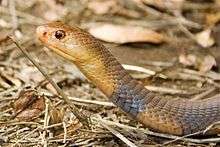 |
N. katiensis | Angel, 1922 | 0 | Mali cobra (Katian spitting cobra) | Benin, Burkina Faso, Cameroon, Ghana, Guinea, the Ivory Coast, Mali, Gambia, Mauritania, Niger, Nigeria, Senegal, Togo |
| N. mandalayensis | Slowinski & Wüster, 2000 | 0 | Mandalay spitting cobra (Burmese spitting cobra) | Myanmar (Burma) | |
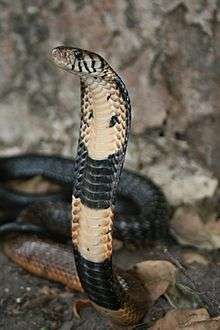 |
N. melanoleuca | Hallowell, 1857 | 0 | Forest cobra | Angola, Benin, Cameroon, the Central African Republic, the Republic of Congo, the Democratic Republic of the Congo (Zaire), Equatorial Guinea, Gabon, Nigeria |
.jpg) |
N. mossambica | Peters, 1854 | 0 | Mozambique spitting cobra | extreme southeastern Angola, Botswana, Malawi, Mozambique, Somalia, northeastern Namibia, South Africa, Swaziland, Tanzania (including Pemba Island), Zambia, Zimbabwe |
| N. multifasciata | Werner, 1902 | 0 | Many-banded cobra | Cameroon, Congo, the Democratic Republic of the Congo (Zaire), Gabon | |
 |
N. naja | (Linnaeus, 1758) | 0 | Indian cobra (spectacled cobra) | Bangladesh, Bhutan, India, Nepal, Pakistan, Sri Lanka |
| N. nana | Collet & Trape, 2020 | 0 | Dwarf water cobra | Democratic Republic of Congo | |
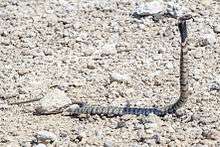 |
N. nigricincta | Bogert, 1940 | 1 | Zebra spitting cobra | Angola, Namibia, South Africa |
.jpg) |
N. nigricollis | Reinhardt, 1843 | 0 | Black-necked spitting cobra | Angola, Benin, Burkina Faso, Burundi, Cameroon, the Central African Republic, Chad, the Democratic Republic of the Congo (Zaire) (except in the central region), Congo, Ethiopia, Gabon, Gambia, Ghana, Guinea-Bissau, Guinea, the Ivory Coast, Kenya, Liberia, Mali, Mauritania, Namibia, Niger, Nigeria, Rwanda, Senegal, Sierra Leone, Sudan, Tanzania, Somalia, Togo, Uganda, Zambia |
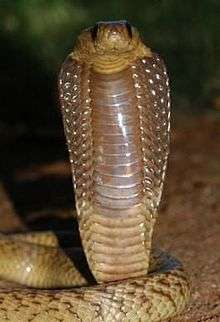 |
N. nivea | (Linnaeus, 1758) | 0 | Cape cobra (yellow cobra) | Botswana, Lesotho, Namibia, South Africa |
| N. nubiae | Wüster & Broadley, 2003 | 0 | Nubian spitting cobra | Chad, Egypt, Eritrea, Niger, Sudan | |
.jpg) |
N. oxiana | (Eichwald, 1831) | 0 | Caspian cobra | Afghanistan, northwestern India, Iran, Kyrgyzstan, Pakistan, Tajikistan, Turkmenistan, Uzbekistan |
 |
N. pallida | Boulenger, 1896 | 0 | Red spitting cobra | Djibouti, Ethiopia, Kenya, Somalia, Tanzania |
| N. peroescobari | Ceríaco, Marques, Schmitz & Bauer, 2017 | 0 | São Tomé forest cobra, cobra preta | São Tomé and Príncipe (São Tomé) | |
 |
N. philippinensis | Taylor, 1922 | 0 | Philippine cobra | the Philippines (Luzon, Mindoro) |
| †N. romani | Hofstetter, 1939 | 0 | †European cobra | Miocene-aged strata of France, Germany, Austria, Romania, and Ukraine | |
| N. sagittifera | Wall, 1913 | 0 | Andaman cobra | India (the Andaman Islands) | |
 |
N. samarensis | Peters, 1861 | 0 | Samar cobra | the Philippines (Mindanao, Bohol, Leyte, Samar, Camiguin) |
| N. savannula | Broadley, Trape, Chirio & Wüster, 2018 | 0 | West African banded cobra | Benin, Burkina Faso, Cameroon, Chad, Gambia, Ghana, Guinea, the Ivory Coast, Mali, Niger, Nigeria, Senegal, Togo | |
| N. senegalensis | Trape, Chirio & Wüster, 2009 | 0 | Senegalese cobra | Benin, Burkina Faso, Ghana, Guinea, Mali, Niger, Nigeria, Senegal | |
 |
N. siamensis | Laurenti, 1768 | 0 | Indochinese spitting cobra | Cambodia, Laos, Thailand, Vietnam |
 |
N. sputatrix | F. Boie, 1827 | 0 | Javan spitting cobra | Indonesia (Java, the Lesser Sunda Islands, East Timor) |
| N. subfulva | Laurent, 1955 | 0 | Brown forest cobra | Angola, Burundi, Cameroon, the Central African Republic, Chad, the Republic of Congo, the Democratic Republic of the Congo (Zaire), Ethiopia, Kenya, Malawi, Mozambique, Nigeria, Rwanda, Somalia, South Africa, South Sudan, Tanzania, Uganda, Zambia, Zimbabwe | |
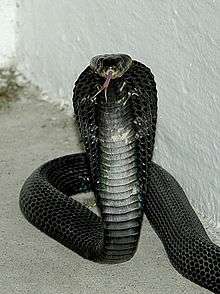 |
N. sumatrana | Müller, 1887 | 0 | Equatorial spitting cobra | Brunei, Indonesia (Sumatra, Borneo, Bangka, Belitung), Malaysia, the Philippines (Palawan), southern Thailand, Singapore |
- Not including the nominate subspecies
† Extinct
T Type species[2]
References
- Spawls, S; Branch, B (1995). The Dangerous Snakes of Africa (1st. ed.). Ralph Curtis Books. ISBN 9780883590294. Retrieved 9 April 2020.
- Zhao, E; Adler, K (1993). Herpetology of China (1st ed.). Society for the Study of Amphibians & Reptiles. p. 522. ISBN 9780916984281. Retrieved 9 April 2020.
- Vogel, G (31 March 2006). Terralog: Venomous Snakes of Asia, Vol. 14 (1 ed.). Frankfurt Am Main: Hollywood Import & Export. p. 148. ISBN 978-3936027938. Retrieved 9 April 2020.
- "Naja". Integrated Taxonomic Information System. Retrieved 13 April 2008.
- Wallach, Van; Wüster, W; Broadley, Donald G. (2009). "In praise of subgenera: taxonomic status of cobras of the genus Naja Laurenti (Serpentes: Elapidae)" (PDF). Zootaxa. 2236 (1): 26–36. doi:10.11646/zootaxa.2236.1.2.
- Wüster, W; et al. (2009). "Integration of nuclear and mitochondrial gene sequences and morphology reveals unexpected diversity in the forest cobra (Naja melanoleuca) species complex in Central and West Africa (Serpentes: Elapidae)". Zootaxa. 4455 (1): 68–98. doi:10.11646/zootaxa.4455.1.3. PMID 30314221.
- "Proto-IE: *(s)nēg-o-, Meaning: snake, Old Indian: nāgá- m. 'snake', Germanic: *snēk-a- m., *snak-an- m., *snak-ō f.; *snak-a- vb". Starling.rinet.ru.
- Mayrhofer, Manfred (1996). Etymologisches Wörterbuch des Altindoarischen. Heidelberg: Universitätsverlag C. Winter. p. II.33. ISBN 978-3-8253-4550-1.
- "Naja melanoleuca - General Details, Taxonomy and Biology, Venom, Clinical Effects, Treatment, First Aid, Antivenoms". WCH Clinical Toxinology Resource. University of Queensland. Retrieved 17 December 2011.
- Khare, AD; Khole V; Gade PR (December 1992). "Toxicities, LD50 prediction and in vivo neutralisation of some elapid and viperid venoms". Indian Journal of Experimental Biology. 30 (12): 1158–62. PMID 1294479.
- Watt, G; Theakston RD; Hayes CG; Yambao ML; Sangalang R; et al. (4 December 1986). "Positive response to edrophonium in patients with neurotoxic envenoming by cobras (Naja naja philippinensis). A placebo-controlled study". New England Journal of Medicine. 315 (23): 1444–8. doi:10.1056/NEJM198612043152303. PMID 3537783.
- Brown, John H. (1973). Toxicology and Pharmacology of Venoms from Poisonous Snakes. Springfield, IL US: Charles C. Thomas. p. 81. ISBN 978-0-398-02808-4.
- Minton, SA (1967). "Paraspecific protection by elapid and sea snake antivenins". Toxicon. 5 (1): 47–55. doi:10.1016/0041-0101(67)90118-3. PMID 6036250.
- Zug, George R. (1996). Snakes in Question: The Smithsonian Answer Book. Washington D.C., US: Smithsonian Institution Scholarly Press. ISBN 978-1-56098-648-5.
- Minton, SA (1974). Venom diseases. Springfield, Ill: Thomas Publisher, Limited, Charles C. ISBN 978-0-398-03051-3.
- Tan, N.H., Choy, S.K., Chin, K.M. and Gnanajothy, P. (1994). "Cross-reactivity of monovalent and polyvalent Trimeresurus antivenoms with venoms from various species of Trimeresurus (lance-headed pit viper) snake". Toxicon. 32 (7): 849–853. doi:10.1016/0041-0101(94)90010-8. PMID 7940592.CS1 maint: multiple names: authors list (link)
- Hauert, Jacques; ichel Maire; Alexandre Sussmann; Dr. J. Pierre Bargetz (July 1974). "The major lethal neurotoxin of the venom of Naja naja phillippinensis: Purification, physical and chemical properties, partial amino acid sequence". International Journal of Peptide and Protein Research. 6 (4): 201–222. doi:10.1111/j.1399-3011.1974.tb02380.x.
- Lysz, Thomas W.; Rosenberg, Philip (May 1974). "Convulsant activity of Naja naja oxiana venom and its phospholipase A component". Toxicon. 12 (3): 253–265. doi:10.1016/0041-0101(74)90067-1. PMID 4458108.
- Brown JH. 1973. Toxicology and Pharmacology of Venoms from Poisonous Snakes. Springfield, Illinois: Charles C. Thomas. 184 pp. LCCCN 73-229. ISBN 0-398-02808-7.
- Gopalkrishnakone, Chou, P., LM (1990). Snakes of Medical Importance (Asia-Pacific Region). Singapore: National University of Singapore. ISBN 978-9971-62-217-6.
- Warrell, David A. "Snake bite" (PDF). Seminar. Lancet 2010 (volume 375, issue 1). Archived from the original (PDF) on 29 October 2013. Retrieved 20 December 2011.
- Norris MD, Robert L.; Minton, Sherman A. (10 September 2013). "Cobra Envenomation". Medscape. United States: Medscape. Retrieved 8 December 2013.
- Solevilla, Rosalinda C (1997). "A preliminary study of the toxic principles from the venom of Naja naja samarensis, Peters". Acta Manilana. 40: 1–6.
- Watt, G.; Padre L; Tuazon L; Theakston RD; Laughlin L. (September 1988). "Bites by the Philippine cobra (Naja naja philippinensis): prominent neurotoxicity with minimal local signs". The American Journal of Tropical Medicine and Hygiene. 39 (3): 306–11. doi:10.4269/ajtmh.1988.39.306. PMID 3177741.
- "Naja oxiana". Clinical Toxinology Resource. University of Adelaide. Retrieved 8 December 2013.
- Latifi, Mahmoud (1984). Snakes of Iran. Society for the Study of Amphibians & Reptiles. ISBN 978-0-916984-22-9.
- Broadley, D.G.; Wüster, W. (2004). "A review of the southern African 'non-spitting' cobras (Serpentes: Elapidae: Naja)". African Journal of Herpetology. 53 (2): 101–122. doi:10.1080/21564574.2004.9635504.
- Naja anchietae at the Reptarium.cz Reptile Database. Accessed 13 April 2007.
- Trape, J.-F.; Chirio, L.; Broadley, D.G.; Wüster, W. (2009). "Phylogeography and systematic revision of the Egyptian cobra (Serpentes: Elapidae: Naja haje) species complex, with the description of a new species from West Africa". Zootaxa. 2236: 1–25. doi:10.11646/zootaxa.2236.1.1.
- Wüster, W.; Broadley, D.G. (2007). "Get an eyeful of this: a new species of giant spitting cobra from eastern and north-eastern Africa (Squamata: Serpentes: Elapidae: Naja)". Zootaxa. 1532: 51–68. doi:10.11646/zootaxa.1532.1.4.
- Naja ashei at the Reptarium.cz Reptile Database. Accessed 13 April 2007.
- Wüster, W.; Crookes, S.; Ineich, I.; Mane, Y.; Pook, C.E.; Trape, J.-F.; Broadley, D.G. (2007). "The phylogeny of cobras inferred from mitochondrial DNA sequences: evolution of venom spitting and the phylogeography of the African spitting cobras (Serpentes: Elapidae: Naja nigricollis complex)". Molecular Phylogenetics and Evolution. 45 (2): 437–453. doi:10.1016/j.ympev.2007.07.021. PMID 17870616.
- Naja nigricincta at the Reptarium.cz Reptile Database. Accessed 29 December 2008.
- Ceríaco, L; et al. (2017). "The "Cobra-preta" of São Tomé Island, Gulf of Guinea, is a new species of Naja Laurenti, 1768 (Squamata: Elapidae)". Zootaxa. 4324 (1): 121–141. doi:10.11646/zootaxa.4324.1.7.
- Nagy, Z.T., Vidal, N., Vences, M., Branch, W.R., Pauwels, O.S.G., Wink, M., Joger, U., 2005. Molecular systematics of African Colubroidea (Squamata: Serpentes). In: Huber, B.A., Sinclair, B.J., Lampe, K.-H. (Eds.), African Biodiversity: Molecules, Organisms, Ecosystems. Museum Koenig, Bonn, pp. 221–228.
External links
| Wikimedia Commons has media related to Naja. |
| Look up naja in Wiktionary, the free dictionary. |
- Naja at the Reptarium.cz Reptile Database. Accessed 13 April 2007.